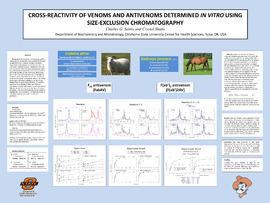| dc.contributor.author | Sanny, Charles G. | |
| dc.contributor.author | Shults, Crystal | |
| dc.date.accessioned | 2020-05-05T19:38:00Z | |
| dc.date.available | 2020-05-05T19:38:00Z | |
| dc.date.issued | 2020-02-28 | |
| dc.identifier | ouhd_sanny_crossreactivityofvenom_2020 | |
| dc.identifier.citation | Sanny, C. G., & Shults, C. (2020, Feb. 28). Cross-reactivity of venoms and antivenoms determined in vitro using size-exclusion chromatography. Poster presented at Research Day at Oklahoma State University Center for Health Sciences, Tulsa, OK. | |
| dc.identifier.uri | https://hdl.handle.net/11244/324246 | |
| dc.description.abstract | Background: Size-exclusion chromatography (SEC) can be used to characterize venom-antivenom immune complex formation. Complex formation would be expected between antivenom and venom used in the antivenom production process. Binding of antivenom with venom not used in the production process might be predicted due to similarities of venom composition, but would typically be confirmed by standard assays, such as inhibition of venom lethality or neutralization of venom toxicity. Evaluation of complex formation is relevant since venom-antivenom binding is required for neutralization of venom lethality or toxicity, though binding does not guarantee protection. SEC may be a useful tool in comparing the binding of different antivenoms to a particular venom, as well as binding of different venoms to a particular antivenom. The data presented in this study demonstrates the use of SEC to evaluate the cross-reactivity of two distinctly different antivenoms with venoms used in antivenom production. Antivenoms: Ovine Fab (FabAV) - Crotalidae Polyvalent Immune Fab (Ovine); Equine F(ab')2 [F(ab')2AV] - Bothropic antivenom, Butantan Institute, Brazil. Venoms: Crotalus atrox (North America) - used in FabAV production; Bothrops jararaca (Brazil) - used in F(ab')2AV production. | |
| dc.description.abstract | Methods: Venom, antivenom, and venom-antivenom mixtures were prepared at 4oC in 50 mM sodium phosphate, pH 7.0, containing 0.15 M NaCl (column elution buffer) and incubated for 30 minutes at 37oC. (Samples were stored at 4oC prior to SEC.) Samples (20 uL) were injected into the SEC column (TSKgel G3000SWxl 7.8 mm ID x 30 cm, 5 um, TOSOH Bioscience) at a constant flow rate of 1 mL/min. Elution profiles were monitored using a photodiode array detector (Waters). Three regions within the elution profiles were chosen for integration based on comparison of control and venom-antivenom mixture profiles. Venom-antivenom binding was estimated from differences between control and venom-antivenom mixture region areas (i.e. DArea). Concentration-dependent changes in DArea were fit to a hyperbolic dose-response function (Eq.1) to estimate DAreamax (maximum binding) and C50 [effective concentration of reactants (C) at one-half DAreamax)]. DArea = DAreamax [C/(C50+C)] Eq. 1 Venom and antivenom reactants and venom-antivenom mixtures were comprised of: (1) C. atrox venom, FabAV; (2) C. atrox venom, F(ab')2AV; (3) B. jararaca venom, F(ab')2AV; and (4) B. jararaca venom, FabAV. | |
| dc.description.abstract | Results: Complex formation was apparent in all four combinations of venoms and antivenoms. C. atrox venom binding to FabAV was greater than to F(ab')2AV. B. jararaca venom, however, bound to F(ab')2AV greater than to FabAV. Venoms used in antivenom production tended to bind preferentially to the respective antivenom product. Concentrations of venoms at one-half DAreamax (C50) were similar for all four combinations of venom and antivenom. | |
| dc.description.abstract | Conclusion: The data presented in this study demonstrate the use of SEC to evaluate the binding of different antivenoms to a particular venom, as well as binding of different venoms to a particular antivenom. SEC may have application in evaluating cross-reactivity of different types of antivenoms and venoms. | |
| dc.format | application/pdf | |
| dc.language | en_US | |
| dc.publisher | Oklahoma State University Center for Health Services | |
| dc.rights | The author(s) retain the copyright of have the right to deposit the item giving the Oklahoma State University Library a limited, non-exclusive right to share this material in its institutional repository. Contact Digital Resources and Discovery Services at lib-dis@okstate.edu or 405-744-9161 for the permission policy on the use, reproduction or distribution of this material. | |
| dc.title | Cross-reactivity of venoms and antivenoms determined in vitro using size-exclusion chromatography | |
| osu.filename | ouhd_sanny_crossreactivityofvenom_2020.pdf | |
| dc.type.genre | Presentation | |
| dc.type.material | Text | |
| dc.subject.keywords | venoms | |
| dc.subject.keywords | antivenoms | |
| dc.subject.keywords | venom-antivenom binding | |
| dc.subject.keywords | size-exclusion chromatography | |
